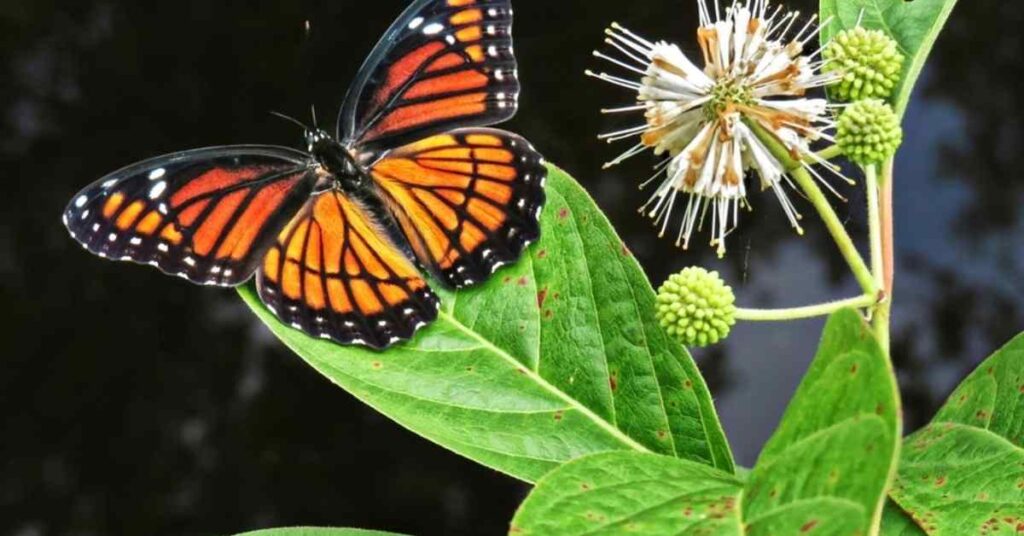Over 160 different species of butterflies have been identified in Georgia, making it one of the most diverse in the country. The Painted Lady, Red Admiral, Viceroy, Spring Azure, American Lady, Buckeye, Spicebush Swallowtail, Eastern Tiger Swallowtail, and Monarch butterflies are among the most common species of butterflies in Georgia.
In this article, we will take a more in-depth look at 22 of the most common and interesting butterflies found in the state of Georgia. You will find pictures, guides to identification, and interesting facts about these 22 Butterflies in Georgia.
Also see Missouri Butterflies: Classification And Identification With Pictures.
Let’s take a detailed look at the 22 of the most common butterflies in Georgia.
Discovering 22 Butterflies in Georgia
#1. Painted Lady (Vanessa cardui)
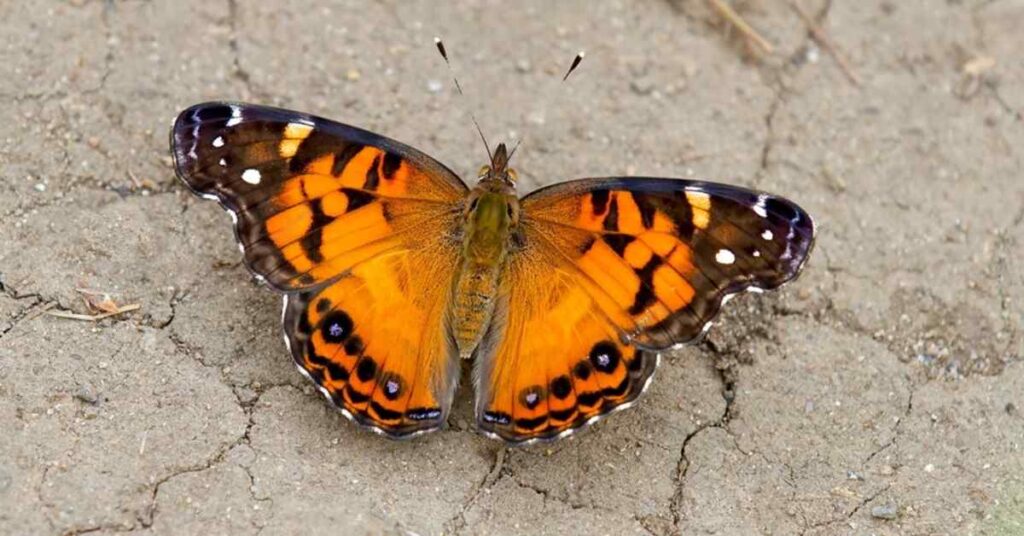
The Painted Lady butterfly is widespread worldwide and can be seen in Georgia from spring through fall.
Painted Lady butterfly measures about 2-3 inches in width.
You will see an orange color with black borders and spots on the upper wings. The underside of the wings is orange and marked with black and white.
The Painted Lady has a strong wingspan and can fly great distances. Large flocks of them can be spotted migrating frequently.
The Painted Lady butterfly is common in open areas such as gardens, meadows, and fields.
Fascinating Facts about Painted Lady Butterfly
- They are one of the world’s most common butterflies, and they can be found on every continent except Antarctica.
- Occasionally, individuals will migrate more than 2,000 miles in a single direction.
- The Painted Lady represents perseverance and optimism due to its ability to thrive despite adverse conditions.
You can raise the caterpillars of the Painted Lady Butterfly at home and in classrooms without using a single plant because they are so adaptable and will eat an artificial diet.
#2. Red Admiral (Vanessa atalanta)
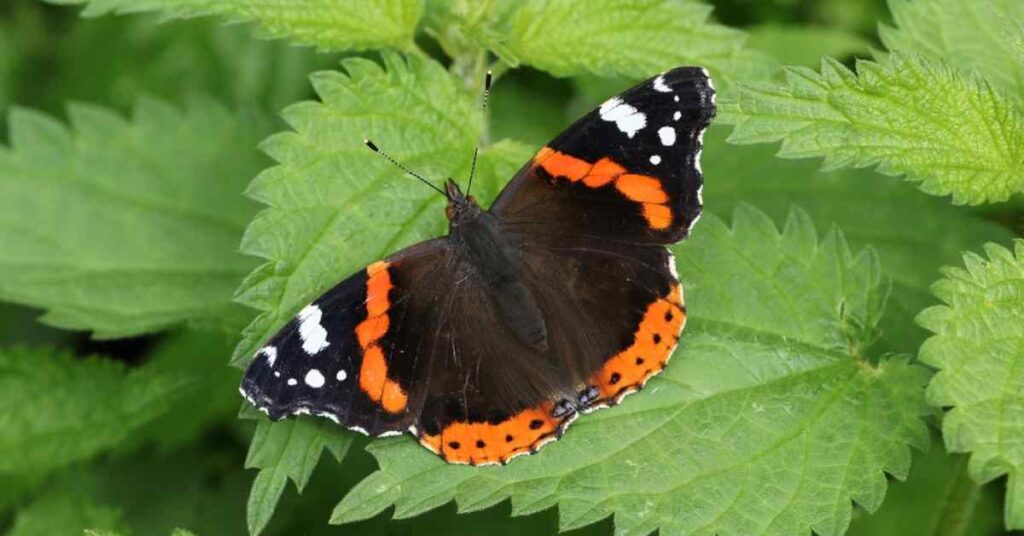
The Red Admiral butterfly also frequently flies around Georgia. Its wingspan is about 2.5 inches, making it a medium-sized butterfly.
You will see black borders and spots on the upper wings of the Red Admiral butterfly. When you look under the wings of these butterflies, you will notice orange and black and white markings on them.
The Red Admiral butterfly is easily identified by the red band that spans its wings.
You can look for Red Admirals in the woods, fields, and gardens. The early spring to the late fall are their peak active times.
The nectar of flowers like daisies, clover, and milkweed is a staple diet for the red admiral butterfly.
Fascinating Facts about Red Admirals
- They are known for traveling long distances; some have seen them travel more than 1,000 miles. The Red Admiral is a sign of hope and strength because it can live in harsh environments.
- The larvae of the Red Admiral are poisonous, and their spines can give people a mild rash.
#3. Viceroy (Limenitis archippus)
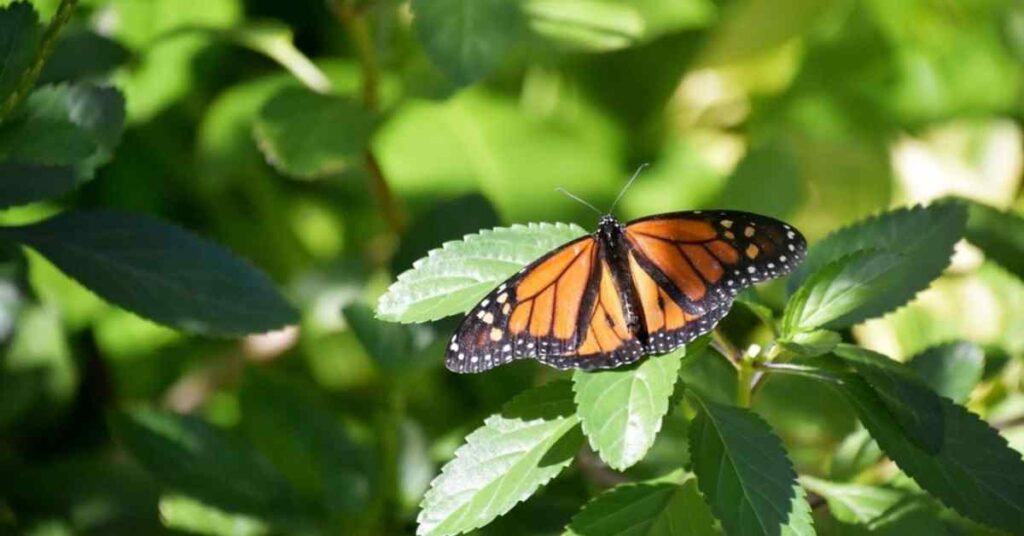
Many people confuse the Viceroy butterfly for a Monarch. In contrast to the Monarch, the Viceroy is smaller. It has a black line on the underside of its hindwing, an attribute the Monarch lacks.
The Viceroy’s wings are also more tapered than the Monarch’s.
Some places to spot a viceroy are forests, meadows, and gardens. The early spring to the late fall are their peak active times.
Flowers like milkweed, thistle, and aster are favorites of viceroys’ nectar diet.
Fascinating Facts about Viceroy Butterfly
- The Viceroy’s coloration is aposematic, which warns predators that it is poisonous.
- The Viceroy Butterfly looks just like the poisonous Monarch butterfly.
- The larvae of the Viceroy butterfly eat milkweed plants, which are toxic to predators because they contain toxins.
#4. Spring Azure (Celastrina ladon)
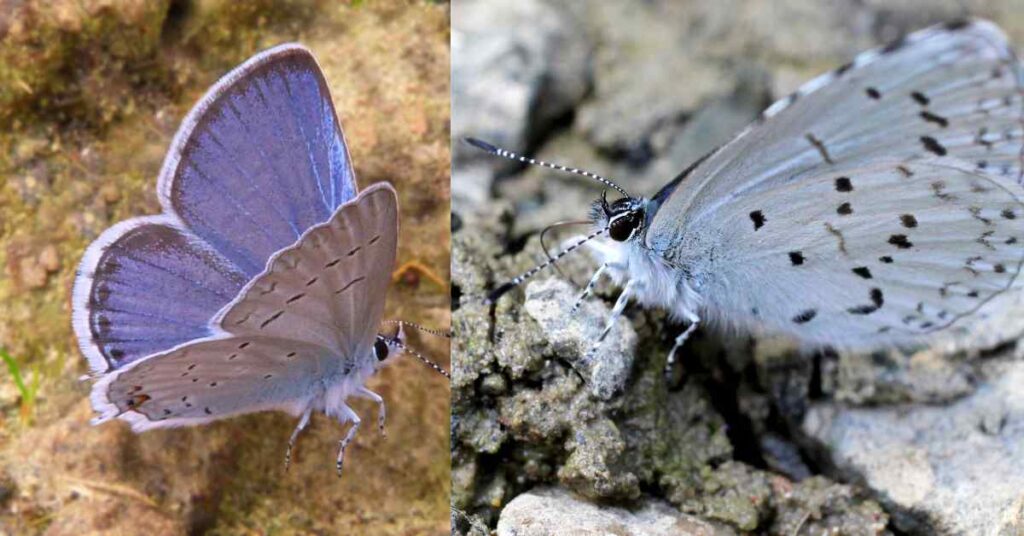
The wingspan of a Spring Azure butterfly is only about 1.5 to 2 inches. The upper wings are white with thin black margins. The underside of the wings is blue and spotted with white.
The Spring Azure is a swift flier, making it tricky to catch a glimpse.
Spring azures like to live in open areas like meadows and fields. Their peak season is the middle to latter part of summer.
Spring Azures feed on nectar-producing violets, bluebells, and clover.
Fascinating Facts about Spring Azures
- The Spring Azure butterfly is notable for being one of the earliest springtime fliers.
- Female butterflies lay their eggs on dogwood leaves. Eggs are laid, and then the larvae start eating the leaves.
- Adults emerge from their pupal stage after about two weeks of larval development.
- The average life expectancy of a Spring Azure is two weeks.
#5. Giant Swallowtail
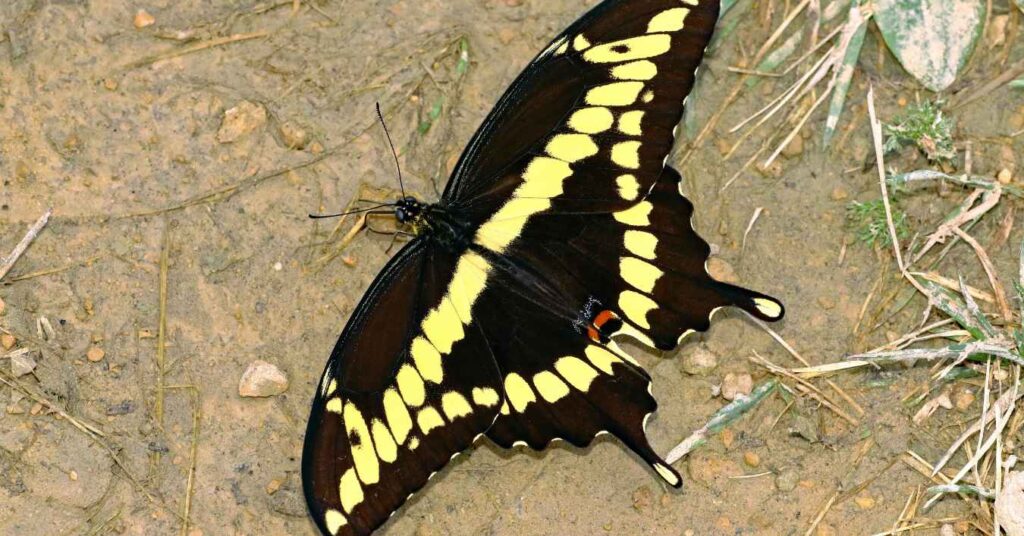
The giant swallowtail butterfly of Georgia is commonly seen in forested areas and along roadways.
The common hoptree, prickly ash, and Hercules’ club are all host plants for this butterfly. The caterpillar, called an “orange dog” due to its resemblance to a bird dropping, feeds exclusively on these plants.
The caterpillar is protected from potential predators by its camouflage.
From late March into October, Georgia is home to swarms of giant swallowtail butterflies.
It has powerful wings and can cover great distances in the air. Caterpillars develop from eggs laid by female butterflies on the leaves of their host plants. After about two weeks of development through four stages as a caterpillar, the adult butterfly emerges from its pupa.
Fascinating Facts of Giant Swallowtail
The Greek word “cresphontes,” which means “victorious,” is where the butterfly gets its name.
The Giant Swallowtail is Alabama, Delaware, Georgia, and South Carolina’s state butterfly.
The osmeterium, a pair of orange glands on the butterfly caterpillar’s head, can secrete a foul-smelling substance. This substance may deter predators.
The giant swallowtail is a widespread butterfly to study, and you can often see it in butterfly gardens and natural areas.
Citrus fruits like lemon, orange, and grapefruit comprise the bulk of the caterpillar’s diet.
#6. Variegated Fritillary
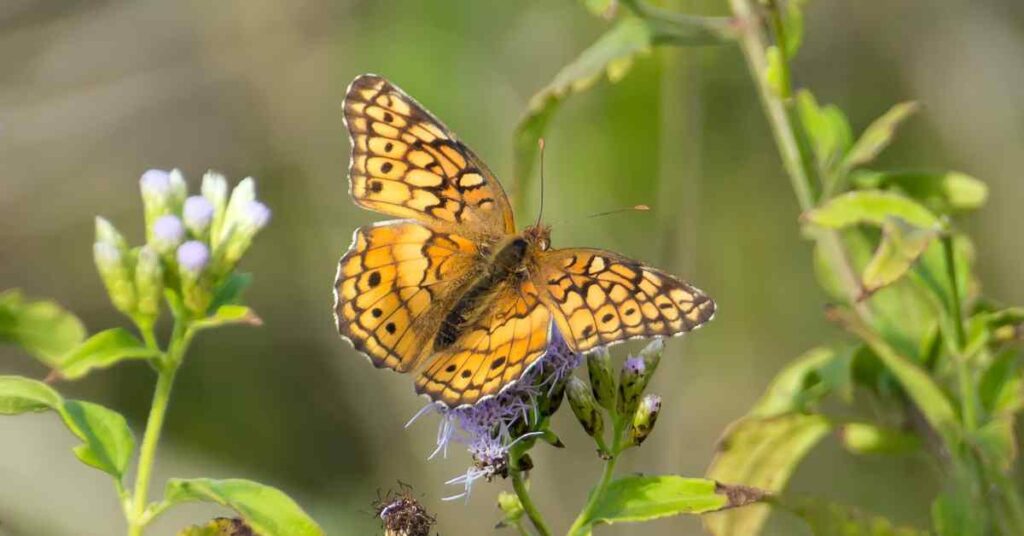
The butterfly’s name comes from the Latin word “variegata,” which means variegated (multicolored)
The Variegated Fritillary is a stunning butterfly with orange-brown and black-striped wings.
It thrives in the sunshine and can be spotted in gardens, roadsides, and fields. Violets, passionflowers, and moonseeds are some of the butterfly’s favorite food sources.
The Variegated Fritillary butterfly is frequently spotted in Georgia from April through October.
It has powerful flights and can cover great distances. The female Variegated Fritillary butterfly lays her eggs on the leaves of its host plant, and about a week later, the eggs hatch into caterpillars.
During its two-week metamorphosis, a butterfly undergoes four distinct stages of development from larva to adult.
Fascinating Facts about Variegated Fritillary
- Spiny caterpillars, also known as pansy worms, get their name because pansies are the plants on which they are most commonly found.
- The black and orange spots on the Variegated Fritillary butterfly mimic the markings of a poisonous snake’s spots, which keeps predators away.
- Because they eat violets, the caterpillars of Variegated Fritillary butterflies are called “fritillary worms.”
- Variegated Fritillary are easily frightened and can be challenging to approach due to their sensitivity.
Its caterpillars produce venomous toxins. Their host plants contain chemicals that cause this effect.
The toxic caterpillars flash their vivid colors to scare away any potential predators.
#7. Coral Hairstreak (Satyrium titus)
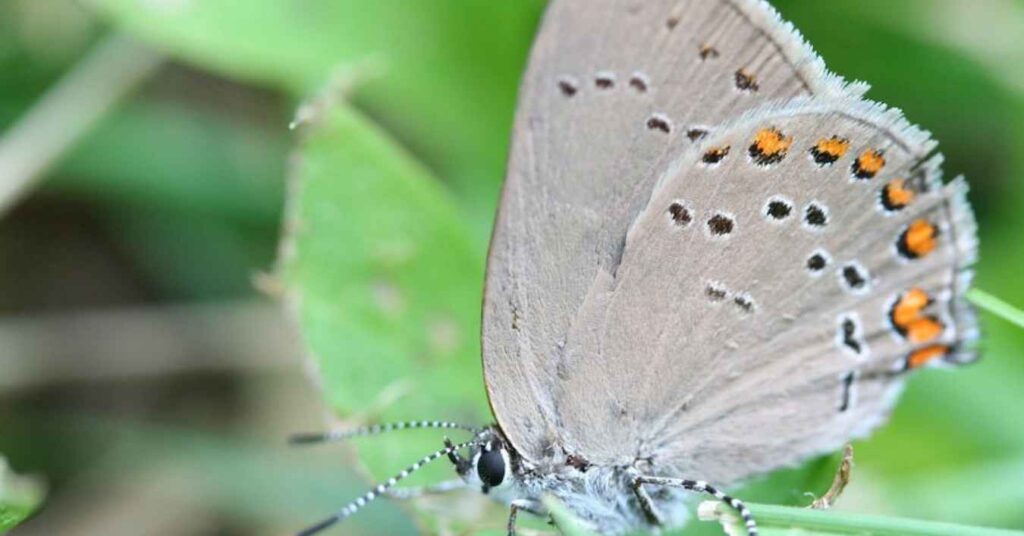
The wingspan of a Coral Hairstreak butterfly is only about 1.5 inches. Brown, orange, and black markings are on the upper wings.
Orange and black and white markings can be seen on the underside of the wings. The hindwing of the Coral Hairstreak is marked by a black “hairstreak.”
Coral Hairstreaks inhabit wooded areas and forests. Their peak season is the middle to latter part of summer. The nectar of dogwood, sourwood, and azalea flowers are favorites of the Coral Hairstreak butterfly.
Fascinating Facts about Coral Hairstreaks
- The vivid coral color of the butterfly’s wings is where the butterfly gets its common name. The underside of the wings is primarily brown, with some orange spots.
- The Coral Hairstreak is a mimic butterfly, which means it imitates the appearance of another, more dangerous species. The Coral Hairstreak is known to imitate the Monarch butterfly.
- Caterpillars of the Coral Hairstreak butterfly eat the leaves of oak trees. The caterpillars are striped green and black, and they sport a pair of orange horns atop their heads.
The Coral Hairstreak butterfly is a migratory species that can be spotted only from spring to fall.
#8. Common Buckeye (Junonia coenia obscura)
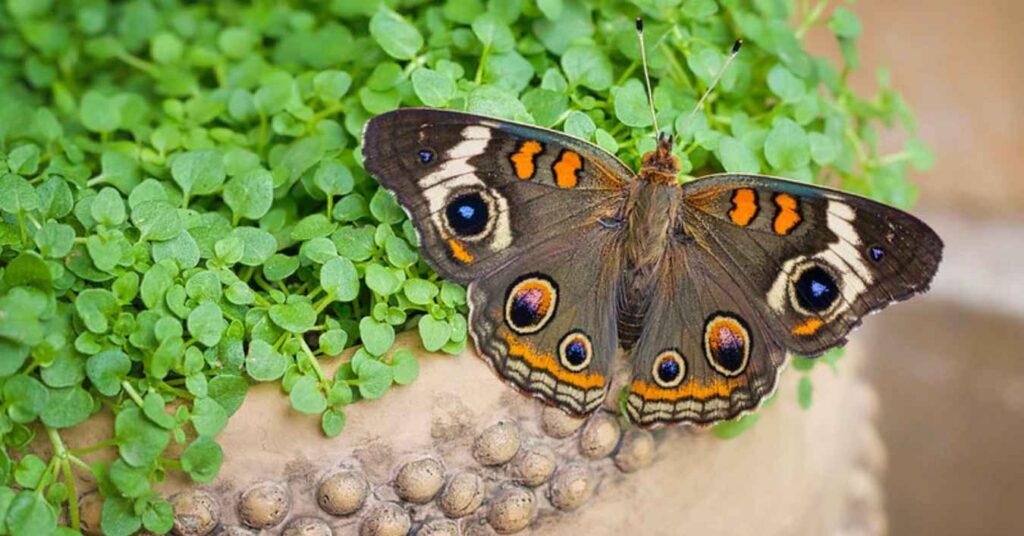
The wingspan of a Common Buckeye butterfly is about 2 to 2.5 inches. Both the borders and spots on the upper wings are black.
Orange and black and white markings can be seen on the underside of the wings. Each Common Buckeye’s back wing features a large black “eyespot.”
The common buckeye can be discovered in woodlands, meadows, and gardens.
The early spring to the late fall are their peak active times. The common buckeye is a nectar feeder that prefers milkweed, thistle, and aster flowers.
Fascinating Facts about the Common Buckeye Butterfly
- The Common Buckeye butterfly’s orange and black markings look like those of a poisonous snake, which keeps predators away.
- Common Buckeye butterfly caterpillars are called “buckeye worms” because they often eat buckeye trees.
#9. Monarch (Danaus plexippus)
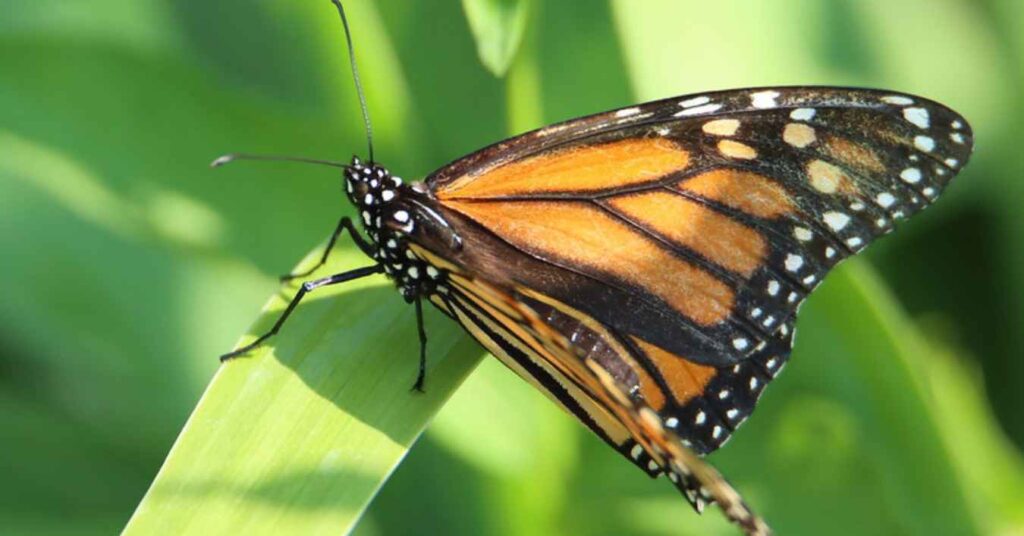
The monarch butterfly is one of the most well-known in the world. It has a wing span of 3–4 inches and is a large butterfly.
Orange with black borders and spots found on the upper wings. The underside of the wings is orange and marked with black and white.
It is easy to recognize the Monarch butterfly due to its black and orange wing pattern.
The monarch butterfly can be spotted in woodlands, fields, and backyards. In the wild, you can find them from springtime to late autumn.
The nectar of flowers like milkweed, thistle, and aster is a staple diet for monarch butterflies.
Monarch butterflies have taste buds on their feet. Because of this, they can enjoy the flavor of the milkweed plants they consume.
The butterflies’ taste receptors also aid in their search for nectar.
Long-distance migration is another characteristic that has made monarchs famous.
Fascinating Facts about Monarch Butterfly
- The Latin word “monarchus,” meaning “king,” is where we get the word “monarch.”
- To communicate with one another, monarch butterflies use a unique scent called Pheromones.
- If you’re looking for a long-lived butterfly, look at the Monarch, which can live for up to nine months.
- Ingestion of a monarch butterfly can be fatal. The milkweed plants they consume as caterpillars are the source of their toxicity.
- The milkweed plants that Monarch butterfly caterpillars eat are toxic due to a compound called cardiac glycoside. The butterfly’s defense mechanism against predators is a toxin stored in the caterpillar’s body.
When traveling long distances, monarch butterflies use a unique navigational system. The sun and the Earth’s magnetic field aid them in their navigation.
#10. Mourning Cloak
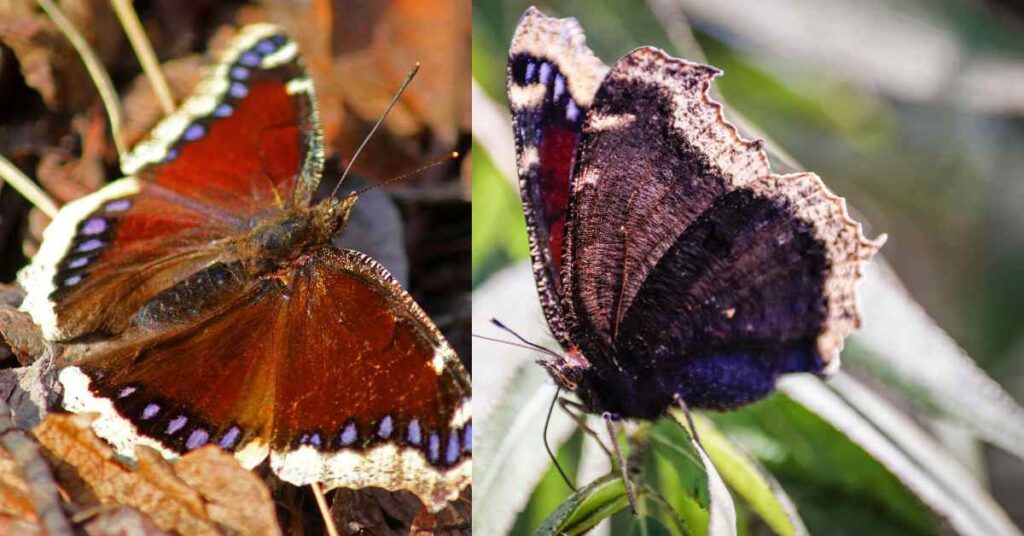
One of North America’s most common butterflies is the Mourning Cloak. All 50 states have them, and Canada and Mexico do as well.
One of the longest-living butterfly species, the Mourning Cloak, can sometimes have a lifespan of up to 10 Months.
It may sometimes be challenging to find due to its preference for cold weather and solitary behaviors.
Fascinating Facts about Mourning Cloak Butterfly
- They have a lot of hair compared to other butterflies. When the temperature lowers below 50 degrees in the spring, the insulation effect of the hair lets them fly.
- During the colder months, they hibernate to conserve energy.
- They acquire toxins from the plants they eat, making them poisonous to predators.
- Mourning Cloak butterfly caterpillars are often called “hickory worms” because they prefer hickory trees as a food source.
#11. Pearl Crescent
The Pearl Crescent butterfly has a short wingspan, at most 2 inches. It can be spotted all over Georgia and the rest of the eastern United States.
The markings on the underside of the butterfly’s wings, which are pearlescent white crescents, are where the butterfly gets its name, which comes from the Latin word “pearly.”
Fascinating Facts about Pearl Crescent Butterfly
- The Pearl Crescent imitates the Viceroy butterfly. Because predators think the Pearl Crescent is the Viceroy, this mimicry helps keep them away.
- The osmeterium, a pair of orange glands found on the caterpillar’s head, can release a foul-smelling substance. It is believed that this substance keeps predators away.
#12. Question Mark
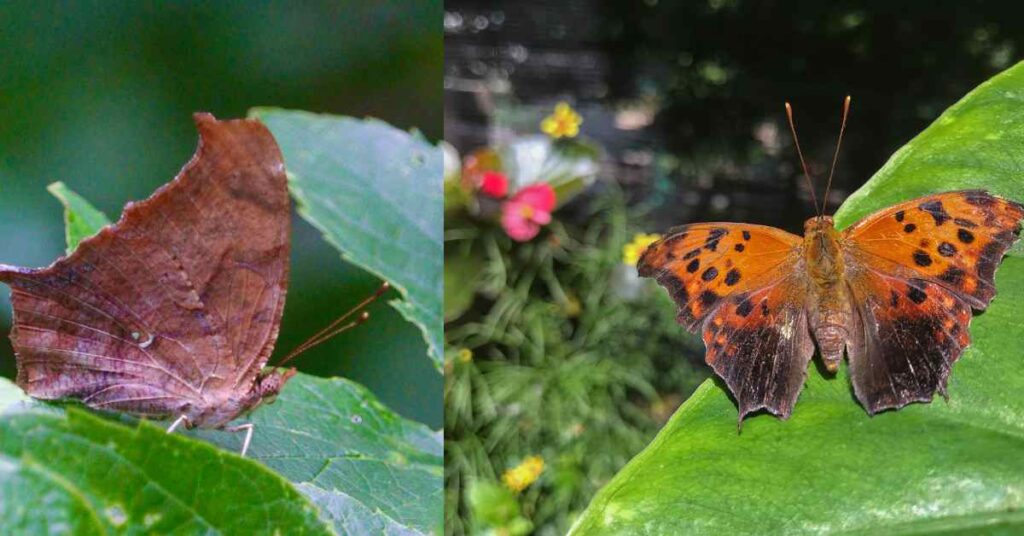
The Question Mark butterfly is common in Georgia, and the months of April through October are the months in which you can observe these butterflies.
The wingspan of this butterfly is somewhere between 2 and 3 inches. It is a medium-sized butterfly.
On the upper surface of the wings, there are black markings, and on the underside of the wings, there is a large question mark marking in white.
Fascinating Facts about Mark Butterfly
- The caterpillars of this butterfly eat the leaves of milkweed. The caterpillars become poisonous because of this,
- The butterfly gets its name from a big white question mark on the underside of each wing.
- The butterfly’s caterpillar can look like a bird dropping, which keeps it safe from being eaten.
- Little Wood Satyr
The wingspan of the Little Wood Satyr butterfly is only about 1 to 1.5 inches. It is widespread across the eastern United States, including Georgia.
“wood-nymph” refers to the butterfly’s diminutive size and habitat preference for wooded areas.
The top of the wings are brown and marked with black, while the underside is covered in white spots.
Fascinating Facts about Little Wood Satyr
- The Latin word “satyrus,” meaning “woodland spirit,” is where the butterfly gets its name.
- The caterpillars eat only grass leaves. The result is a poisonous caterpillar.
#14. Gulf Fritillary (Dione vanillae)
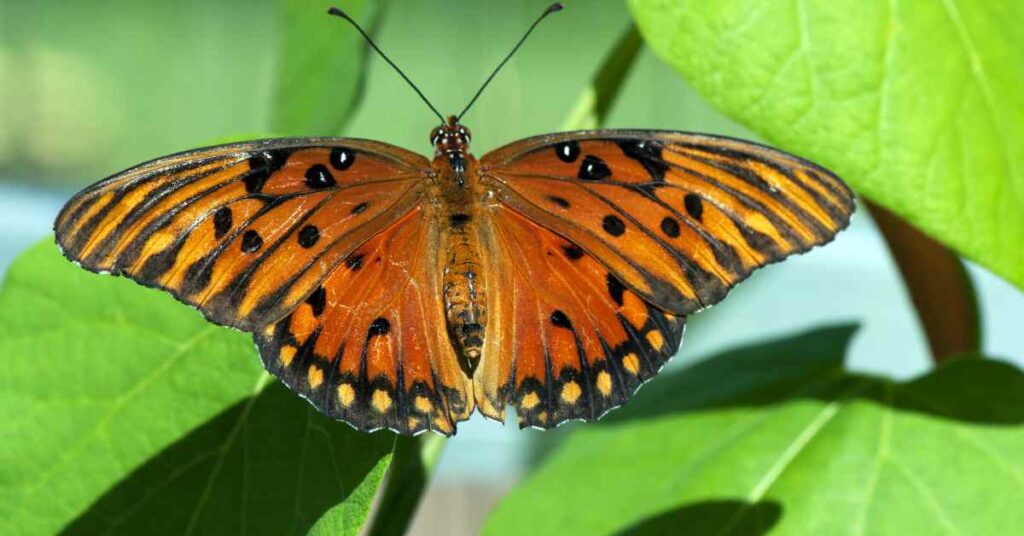
The Gulf Fritillary is a relatively large butterfly with a wing span of 2.5 to 3.5 inches. It can be found all over Georgia in places like fields and meadows with plenty of open space.
The upper wings are orange and spotted or bordered in black. There are black, white, and blue markings on the orange underwings. Each hind wing of a Gulf Fritillary features a black “eyespot,” making this species easily recognizable.
Fascinating Facts about Gulf Fritillary
- Caterpillars of the Gulf Fritillary feed on passionflowers, which are toxic to most animals. They can detoxify the poison, and the caterpillars benefit from it by being safer from predators.
- It’s a migratory butterfly. The adults fly south to Mexico for the winter and return to Georgia in the spring.
#15. American Snout
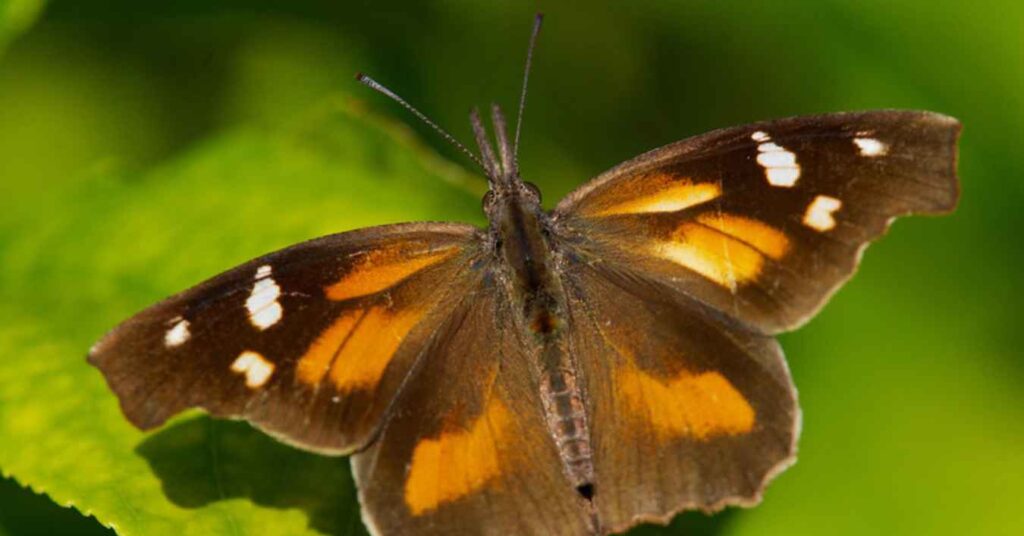
The wingspan of the American Snout butterfly is between 1.5 and 2 inches. It can be found all over Georgia in open fields and meadows. The brown upper wings have orange and black spots. The markings on the orange lower wings are black and white. The American Snout butterfly has a point on its head that looks like a snout.
Fascinating Facts about American Snout Butterfly
- The butterfly’s pattern and coloring are so good at making it look like dead leaves that it’s easy to miss even when it’s right in front of you.
- The butterfly’s proboscis, which looks like a snout, is used to sip nectar from flowers.
- The American Snout butterfly is one of the few species capable of reverse flight.
#16. Cloudless Sulphur (Phoebis sennae)
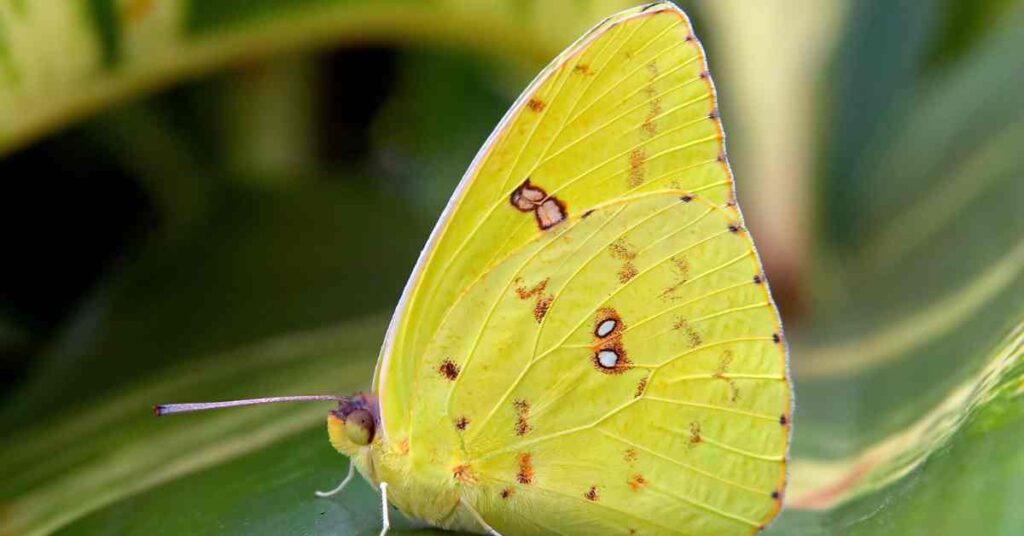
The Cloudless Sulphur butterfly, found in Georgia, is a beautiful and unusual species.
Its wings are a vivid lemon yellow without the usual black borders of other sulfur butterflies. Often traveling thousands of miles, these graceful insects are known for their extraordinary migrations.
They like to hang out in the open, where there are lots of flowers to nectar from and occasionally rotted fruit.
Cloudless Sulphurs have been observed imitating toxic butterflies to avoid being eaten by predators. Their presence brightens Georgia’s scenery, making it more appealing to those who enjoy nature and the arts.
Fascinating Facts about Cloudless Sulphurs
- The Cloudless Sulphur is a fast-flying butterfly often seen in large numbers.
- The butterfly’s scientific name, Phoebis sennae, comes from the Greek words phoebe, which means “shining,” and sennae, which refers to the host plants of the butterfly’s caterpillars, members of the genus Senna.
#17. Zebra Longwing butterflies (Heliconius charithonia)
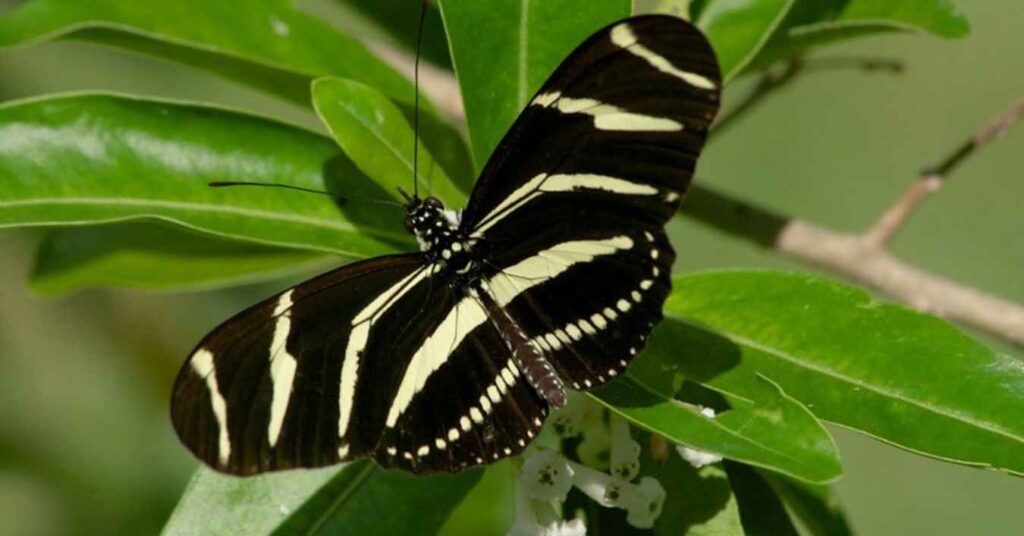
The Zebra Longwing butterfly is a fascinating and distinctive species native to Georgia in the United States.
Their long, black wings with bright yellow stripes make them stand out from other species of butterflies.
In contrast to most butterflies, they subsist primarily on pollen and nectar, making them beneficial pollinators.
Fascinating Facts about Zebra Longwing Butterfly
- Heliconius charitonius is the butterfly’s scientific name. It comes from the Greek words helikos, which means “helix,” and chion, which means “snow,” referring to the white markings on the butterfly.
- Their communal roosting habits, where they gather in large groups in trees at night for safety,
- Some species can live for up to six months.
- After hatching the eggs, the caterpillars eat the passion vine leaves and change into moths.
#18. Carolina Satyr (Hermeuptychia sosybius
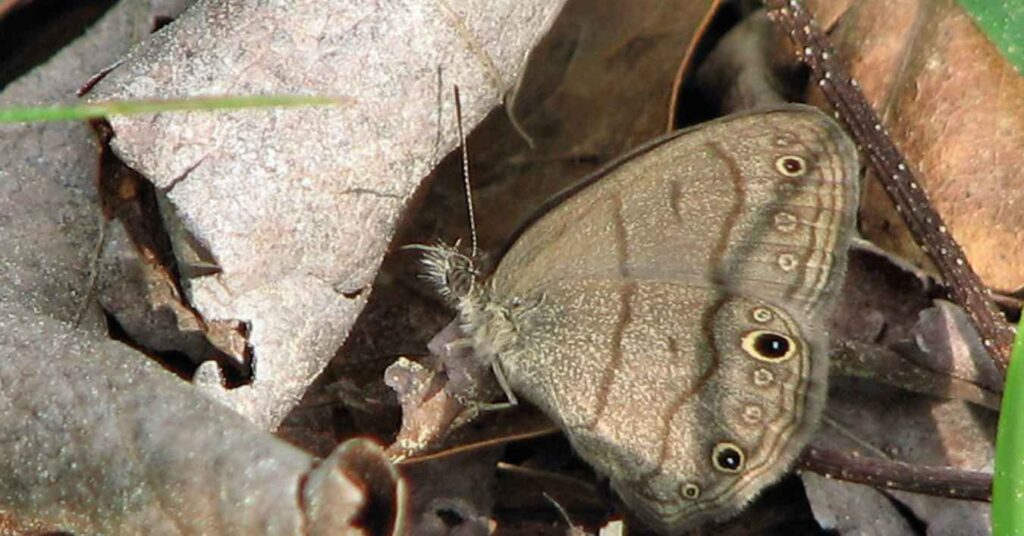
Many Carolina Satyr butterflies in Georgia, USA, add a lovely splash of color to the state’s landscapes.
These tiny creatures are easily recognizable with a wing span of only about an inch, a delicate brown color, and distinctive eye spots on each wing.
The habitat preference of Carolina Satyrs is also an intriguing feature of these creatures. They like grasslands, meadows, and the outskirts of forests because they can find grasses and sedges, their preferred host plants for laying their eggs.
These butterflies are adaptable and resilient because they thrive in human-disturbed environments like parks and gardens.
Fascinating Facts about Carolina Satyrs
- The butterfly’s scientific name, Hermeuptychia sosybius, comes from the Greek words hermes, which means “messenger,” and uptychia, which means “leap,” referring to its erratic flight pattern.
- The Carolina Satyr butterfly flies slowly and often rests on flowers or leaves.
#19. Alfalfa Butterfly (Colias eurytheme)
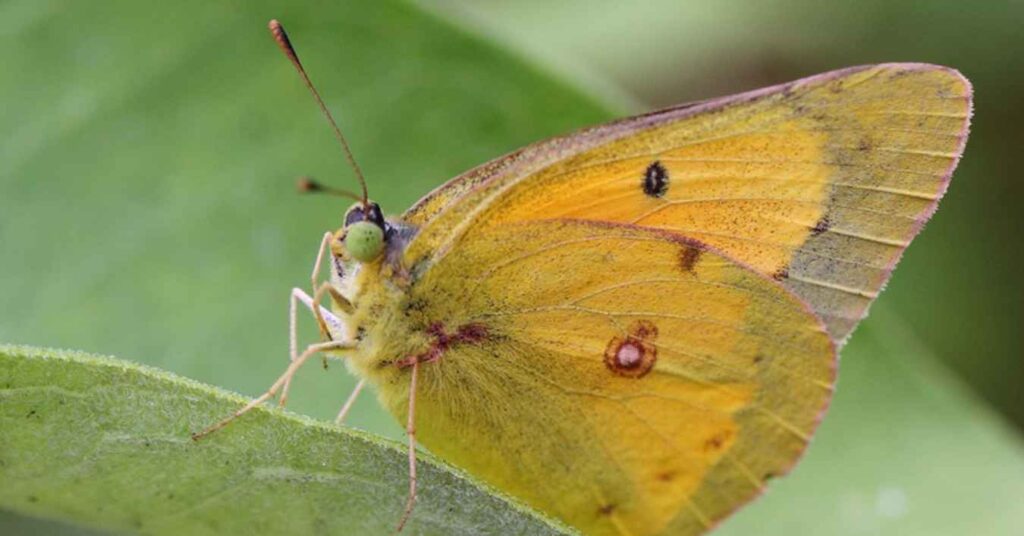
It is also known as an orange Sulphur Butterfly. The wingspan of an Alfalfa Butterfly is approximately 1.5 to 2 inches, making it a relatively small butterfly species. It can be found in Georgia and most other states in the United States.
The butterfly gets its name because its preferred habitat is alfalfa fields. Both the upper and undersides of the wings are yellow, but the bottoms of the wings have black spots on them. The upper side of the wings has yellow borders.
Fascinating Facts
- The Alfalfa Butterfly is a seasonal butterfly that can only be seen from spring to fall.
- The name of the butterfly comes from two Greek words: “colias,” which means “swallow,” and “eurytheme,” which means “wide-banded.”
- The butterfly’s caterpillar can look like a bird dropping, which keeps it safe from being eaten.
#20. Little Copper (Lycaena phlaeas)
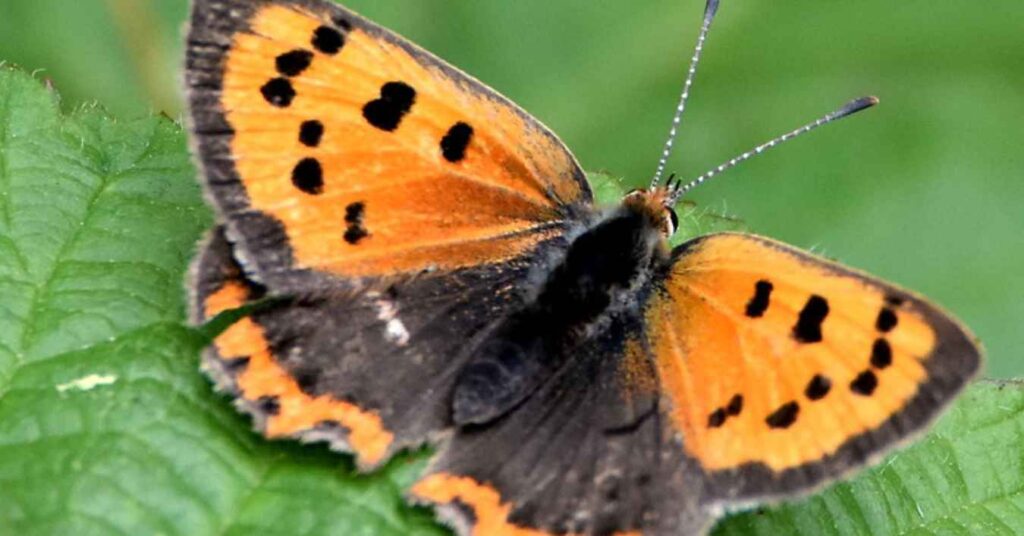
The Little Copper Butterfly is a relatively small butterfly species, with a wing span of only about 1 to 1.25 inches on average. It is also common in Georgia and other parts of the eastern United States.
The butterfly’s name comes from its small size and its coppery coloration.
The top side of the wings is coppery and marked with black, while the underside is orange and marked with black.
Fascinating Facts about Little Copper Butterfly
- The fact that it looks like the more dangerous Monarch butterfly protects it from being eaten.
- The Little Copper Butterfly is a summer and fall flier only.
- The butterfly gets its name from the Latin word for copper, cuprum.
#21. Queen (Danaus gilippus)
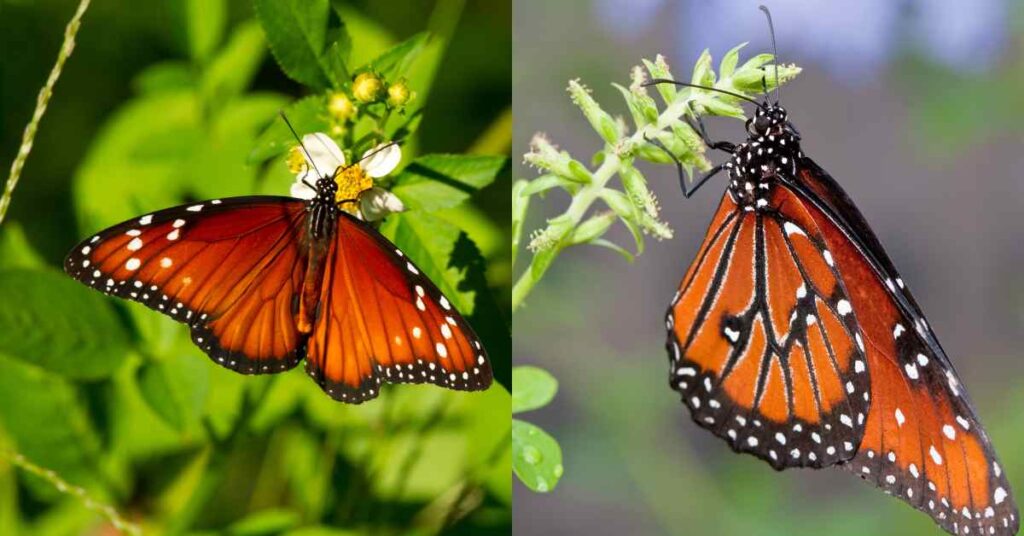
The wingspan of a mature Queen Butterfly is between 2.5 and 3 inches. It is widespread across the eastern United States, including Georgia.
The butterfly’s orange and black coloring makes it look like the Queen of Hearts from a deck of cards, hence the name. Both the upper and lower surfaces of the wings are orange and marked with black spots.
Queen resembles the Monarch butterfly, but its size and wing pattern set it apart.
The queen butterfly is a masterful flier that frequently undertakes long-distance migrations.
The Queen prefers sunny, open areas such as fields, dunes, deserts, pastures, roadside, and waterway margins.
The Queen caterpillar is yellow, white, and black. It looks very similar to the Monarch caterpillar except for a third set of filaments running down its middle.
Fascinating Facts about Queen Butterfly
- Males go on patrols to find potential mates, and females may mate as many as 15 times a day.
- Hair-pencils are a male reproductive organ that plays a vital role in courtship. These hair pencils could play a role in releasing pheromones during courtship, which could attract potential mates.
- The Monarch (Danaus plexippus) and the soldier butterfly (Pieris soldieri) are close relatives of the queen butterfly, which resembles very closely.
The butterfly’s diet consists primarily of nectar from flowers and decaying foliage. Still, it will also consume rotting fruit, sweat, and dry or wet dung if necessary.
#22. White Peacock (Anartia jatrophae)
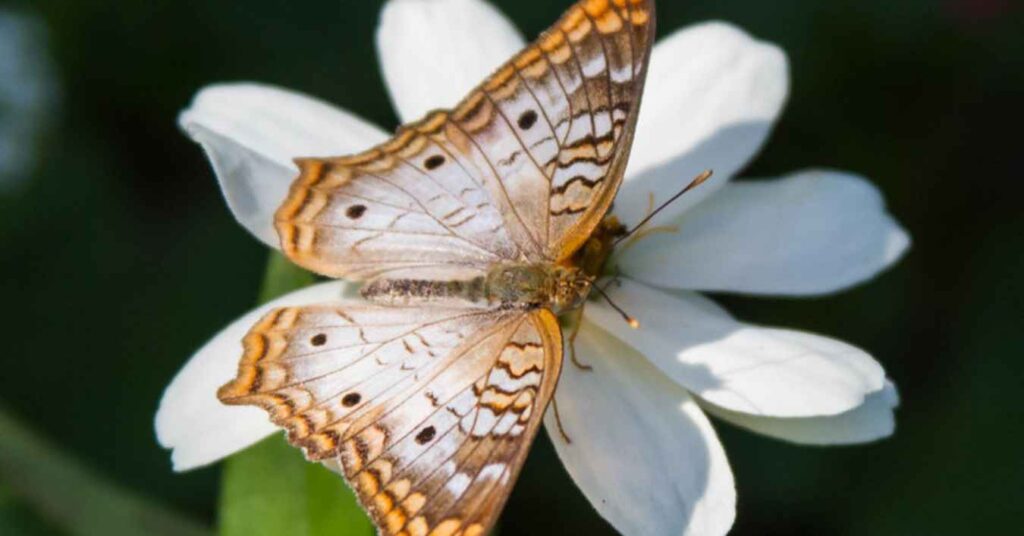
The White Peacock butterfly is a relatively small species with a wing span that ranges between 2 and 2.5 inches.
It is widespread across much of the southeastern United States, including Georgia, where it is found.
Despite their rapid and somewhat erratic flight patterns, their size and color scheme make them easy to spot.
Both genders of white peacocks share the same overall appearance, which consists of a predominantly white body with one large dark spot on the forewings and two smaller dark spots on the hindwings.
A series of brown and orange crescents adorn the outer edges of both the fore and hind wings.
White peacock butterflies are frequently spotted in grassy, weedy, and sunny locations with plenty of nearby water (usually a pond or stream) in the warmer months.
If you’re looking for adult butterflies, look in roadside ditches, parks, and fields with weedy, low-lying host plants.
Fascinating Facts about White Peacock Butterfly
- Its caterpillars eat water hyssop. This makes caterpillars poisonous, and their osmeterium, with two orange glands on their heads, emits a foul-smelling substance that deters predators.
- The butterfly gets its name from a peacock-like eyespot on its underside.
- Unique territorial behavior is displayed by the males of this species, who claim an area of around 15 square meters of space that contains larval host plants. While perched there, they aggressively keep other insects and male white peacocks out.
The water hyssop, lemon bacopa, tropical water hyssop, frogfruit, lanceleaf frogfruit, and Carolina wild petunia are some of the plants that the larvae of the white peacock butterfly feed on.
Related Posts:
Kansas Butterflies: 22 Stunning Species You Should Know About
16 Most Common Butterflies In Connecticut: Pictures And Identifying Features
16 Most Common New Hampshire butterflies (Identifying features with pictures)
16 Most Common Pacific Northwest Butterflies (ID Features With Pictures)
22 Most Common Butterflies in New Mexico: Pictures and Identifying Features
Final Thoughts On Discovering 22 Butterflies in Georgia (Pictures, ID Tips & Facts)
You can see butterflies in Georgia ranging from the tiny Little Wood Satyr to the massive and brightly colored Giant Swallowtail. This article covers 22 of the most common butterflies in Georgia, including photographs, butterfly identification tips, and facts about Georgia butterflies.
You can easily identify the butterflies you see in your backyard or while embarking on butterfly watching in Georgia with just a little bit of research and time.
You’ll be fortunate to spot a rare species like the Spicebush or Eastern Tiger Swallowtail.
Take a moment to observe butterflies the next time you’re out in nature. What you uncover may come as a complete surprise to you.

